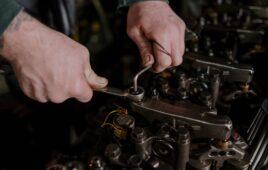Written by Jody Muelaner

A turnbuckle can be used to press sheet metal together to join without fasteners, welds, or adhesive.
A turnbuckle, also known as a bottlescrew, is a device consisting of two threaded eye bolts with opposite handed threads that are screwed into each end of a frame. When the central frame rotators, the eye bolts are prevented from doing so because the two bolts have opposite handed threads. This causes the bolts to simultaneously move inwards or outwards.
The tapped holes at each end of the frame must also have opposite handed threads to accept the bolts. The end with the right handed thread is usually marked with an R and the end with a left handed thread is marked with an L.
Typically, turnbuckles are used to adjust the tension in cables and tie rods. These components are available in a wide range of sizes, from small units designed to tension fencing wire, through to turnbuckles, weighing several tons that form structural elements of large buildings.
In a tensioning application, both bolts should be fully extended before fitting. The turnbuckle can then be screwed up until the desired tension is achieved. For a turnbuckle to adjust the tension, the bolts must be prevented from rotating while the frame is rotated. This means that some initial twisting of cables may occur until the torque in the cables is sufficient to overcome the friction in the turnbuckle.
However, because of the opposite threads, there’s no need for the cables to become twisted as the turnbuckle is tightened.
Turnbuckles are specified by:
- Thread diameter, with larger threads able to carry higher loads. It should be noted however, that a 12 mm thread turnbuckle typically has a much lower load limit than a 12 mm eye bolt or a 12 mm diameter cable.
- Take up is the total difference in length between the turnbuckle with the threads screwed all of the way in or out. Take up can be increased by attaching two or more turnbuckles in line.
- End fittings may be eye bolts, hooks or shackles. Shackles may also be referred to as jaw end fittings. Many turnbuckles have an eye at one end and a shackle at the other. Toggle jaw end fittings allow rotation of the turnbuckle in any direction.
- Working load limit should be carefully matched to the application. This is likely to result in turnbuckles with threads of larger diameter than that of cables and eye bolts in the tensioning system.
- Material. Turnbuckles are available in galvanized steel for most construction and industrial applications, as well as in stainless steel for use offshore, in critical applications or in exposed architectural features.





Tell Us What You Think!